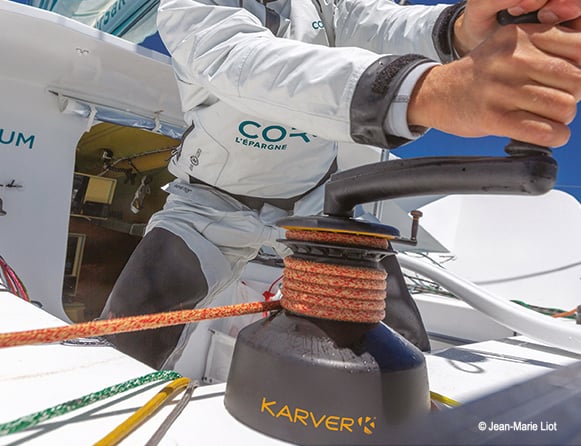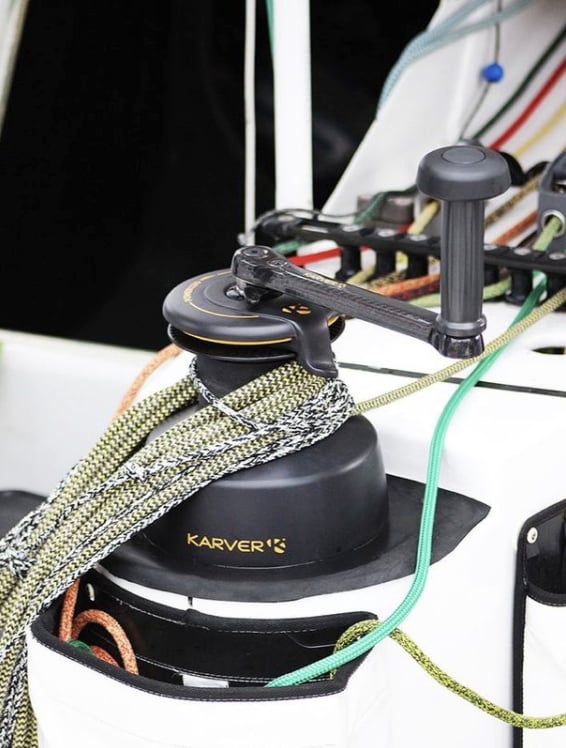
Karver are relatively new to the world of sailboat winches but they are bringing something completely different to the market. Their KSW Speed and KPW Power winch ranges may not suit every application but by being totally unique, if you fall in their sweet spot, they can offer some dramatic advantages.
In 2018 Karver took over a Brittany (France) based manufacturer, Pontos Winches, and in spring 2019 launched a fully updated range. The key difference is that these self-tailing, manual winches have x4 automatic gears that utilise epicyclic gear trains and automatic load detection. There are just three sizes (40, 46 and 52), but by being clever with the gear ratios they have created two distinct ranges orientated to either SPEED or POWER.
The four gears are, in effect, two sets of x2 gears with a physical load sensor in the drum responsible for switching between gears 1&2 to 3&4. The user simple changes winding direction to seamlessly change gears WITHOUT the need for any switch or button.
|
|
Harken Radial 40 |
Andersen 40 |
Karver KSW 40 SPEED |
Karver KPW 110 (40) POWER |
|
Speeds / Gears |
2 |
2 |
4 |
4 |
|
Drum Base Ø(mm) |
157 |
152 |
171 |
171 |
|
Drum Ø (mm) |
80 |
75 |
84 |
84 |
|
Height (mm) |
175 |
172 |
189 |
189 |
|
Weight (g) |
3800 |
4900 |
5700 |
5500 |
|
SWL (kg) |
850 |
N/A |
850 |
1000 |
|
Maximum Line Ø (mm) |
12 |
14 |
12 |
12 |
|
Gear / Power Ratio 1 |
2.1 / 13.5 |
1.3 / 8.9 |
0.4 / 2.3 |
1.9 / 11.6 |
|
Gear / Power Ratio 2 |
6.3 / 39.9 |
6.0 / 40.0 |
1.3 / 8.0 |
5.4 / 32.7 |
|
Gear / Power Ratio 3 |
|
|
1.9 / 11.6 |
6.6 / 40.0 |
|
Gear / Power Ratio 4 |
|
|
6.6 / 40.0 |
18.7 / 112.9 |
The above table shows two market leading, self-tailing, size 40 winches from Harken and Andersen and compares them to a Karver KSW Speed 40 and the KPW Power alternative.
The Harken / Andersen winches are representative of most other winches available on the market. They have similar drum base diameters and heights. The drum diameter is smaller on the Andersen winch which means there is less line on the drum. This translates to slower lines speeds (for a given gear ratio) and to achieve the same grip requires extra turns on the winch.
By comparison, in terms of physical appearance the Karver winches have a bigger base diameter and are taller / heavier, which is due to the increased space/weight required for the extra gears and automatic load detection system. The drum diameter is also bigger which provides greater line speed and improved grip, which comes into play for both the Speed and Power ranges.
However, it is the gear/power ratios which provide the really striking difference between the Karver Speed/Power winches and the rest of the competition. In very simplistic terms:
• Power ratio is the increase in the force being applied to the line
o This is a function of gear ratio, drum diameter and winch handle length.
• Gear ratio is the number of turns of the handle to one turn of the winch drum
For a more detailed understanding of winch gearing and power ratios, please refer to our previous blog here.
KPW Power
The industry standard for naming winches (e.g. "Size 40") is derived from the maximum Power ratio. But this is where the Karver KPW Power totally rocks the boat! You can see that gear/power ratios 1 & 3 of the KPW are very similar to the Harken / Andersen winches but then gear 4 delivers almost 3x more power than the other two, which is why it is called a Size 110. However, this winch is really still only a size 40 winch by every other measure. The KPW Power is designed for the same line diameters and overall SWL to a standard size 40 winch, but it is coming from a completely different perspective. This winch is not designed to exert any more power on the line, it is designed to exert the same amount of power with a “fraction of the effort” required with other winches.

But what can you use all this effortless power for? KPW winches can be used as coach roof winches where you are constantly fine-tuning headsail and main halyard tensions. It makes it very easy to make small incremental adjustments at high load.
However, the main application Karver see for this winch is as a primary genoa winch. The first gear is similar to other winches but then there is an easy, smooth transition through gears 2, 3 and 4 as the load on the sheet increases and then getting the final 6 inches of trim on your overlapping genoa becomes a “breeze”! The KPW Power range is being marketed as a bridge / stepping-stone between standard manual and electric winches. Many people switch to electric winches to reduce the effort required to manage their sail plan but the Karver KPW could achieve the same objective for a significantly lower cost than electrification.
KSW Speed
The KSW Speed range is aimed at a completely different user. As you can see from the above table, this is a true size 40 winch, with maximum power ratio of 40:1. The top two gears are similar to a standard race winch, but gears 1&2 are all about line speed. In gear one a 0.4 rotation of the winch handles equals a single drum revolution. This is a completely different proposition to most winches which have a first gear requiring 1.5 – 2 turns of the handle for every drum revolution. This winch is aimed specifically at race boats with muscular crew, to increase the speed and efficiency of tacking / gybing manoeuvres.
Summary
The Karver KSW Speed and KPW Power winch ranges are unique. The KSW Speed range is going to be suitable for a very narrow group of serious race boats, however the KPW Power range offers significant benefits for quite a wide range of sailors on 30-45ft boats. They are suitable for short-handed sailing, an ageing crew and an alternative to switching to electric winches.
If you have any questions about Karver winches, please feel free to email us at support@upffront.com, or click the link below to see our full range:



